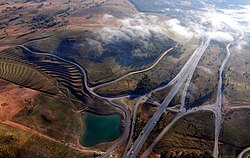
Back الطرق السريعة في أستراليا Arabic Highways in Australien German بزرگراههای استرالیا Persian Liste des autoroutes d'Australie French オーストラリアの幹線道路 Japanese Klasy i kategorie dróg w Australii Polish



Highways in Australia are generally high capacity roads managed by state and territory government agencies, though Australia's federal government contributes funding for important links between capital cities and major regional centres. Prior to European settlement, the earliest needs for trade and travel were met by narrow bush tracks, used by tribes of Indigenous Australians. The formal construction of roads began in 1788, after the founding of the colony of New South Wales, and a network of three major roads across the colony emerged by the 1820s. Similar road networks were established in the other colonies of Australia. Road construction programs in the early 19th century were generally underfunded, as they were dependent on government budgets, loans, and tolls; while there was a huge increase in road usage, due to the Australian gold rushes. Local government authorities, often known as Road Boards, were therefore established to be primarily responsible for funding and undertaking road construction and maintenance. The early 1900s saw both the increasingly widespread use of motorised transportation, and the creation of state road authorities in each state, between 1913 and 1926. These authorities managed each state's road network, with the main arterial roads controlled and maintained by the state, and other roads remaining the responsibility of local governments. The federal government became involved in road funding in the 1920s, distributing funding to the states. The depression of the 1930s slowed the funding and development of the major road network until the onset on World War II. Supply roads leading to the north of the country were considered vital, resulting in the construction of Barkly, Stuart, and Eyre Highways.
The decades following the war saw substantial improvements to the network, with freeways established in cities, many major highways sealed, development of roads in northern Queensland and Western Australia under the Beef Cattle Roads Grants Acts, and interstate routes between Sydney and Melbourne upgraded. In 1974, the federal government assumed responsibility for funding the nations most important road links, between state and territory capitals cities, which were declared National Highways. Some sections of the 16,000-kilometre-long (9,900 mi) National Highway system were no more than dirt tracks, while others were four lane dual carriageways. The network was gradually improved, and by 1989, all gravel road sections had been sealed. In the following decades, the National Highway system was amended through legislation, and was eventually superseded in 2005 by the broader National Land Transport Network, which included connections to major commercial centres, and intermodal freight transport facilities.
The first route marking system was introduced in the 1950s by the Conference of State Road Authorities, which later became the National Association of Australian State Road Authorities (NAASRA) and then Austroads. National Routes were assigned to significant interstate routes "which, both now and in the future, comprise the more important arteries of road communications throughout Australia in all its aspects".[1] East–west routes were planned to have even numbers, increasing from south to north, while north–south routes would have odd numbers, with numbers increasing from east to west. National Route 1 would be an exception, as a "circumferential route along the coastline of Australia".[1] A state route marking systems was designed to supplement the national system, for inter-regional and urban routes within states. Each state could choose their own numbering scheme, as long as National Route and State Route numbers were not duplicated in the same state, or nearby routes in another state.[1] When the National Highway system was introduced, National Routes along it became National Highway routes with the same numbers, but with distinctive green and gold route markers. During the 1990s, planning began for a new alphanumeric route system.[2] Alphanumeric routes have been introduced in most states and territories in Australia, partially or completely replacing the previous systems.[3]
- ^ a b c National Association of Australian State Road Authorities (1976), Guide to the publication and policies of N.A.A.S.R.A. : current at December 1975 (10th ed.), Sydney
- ^ Austroads (1997), Towards a Nationally Consistent Approach to Route Marking
- ^ Roads And Maritime Services (25 February 2013). "Questions and answers: A better way to navigate NSW roads" (PDF). Government of New South Wales. p. 9. Archived (PDF) from the original on 17 November 2013. Retrieved 17 November 2013.
Most States and Territories in Australia are moving to an alpha-numeric road numbering system.